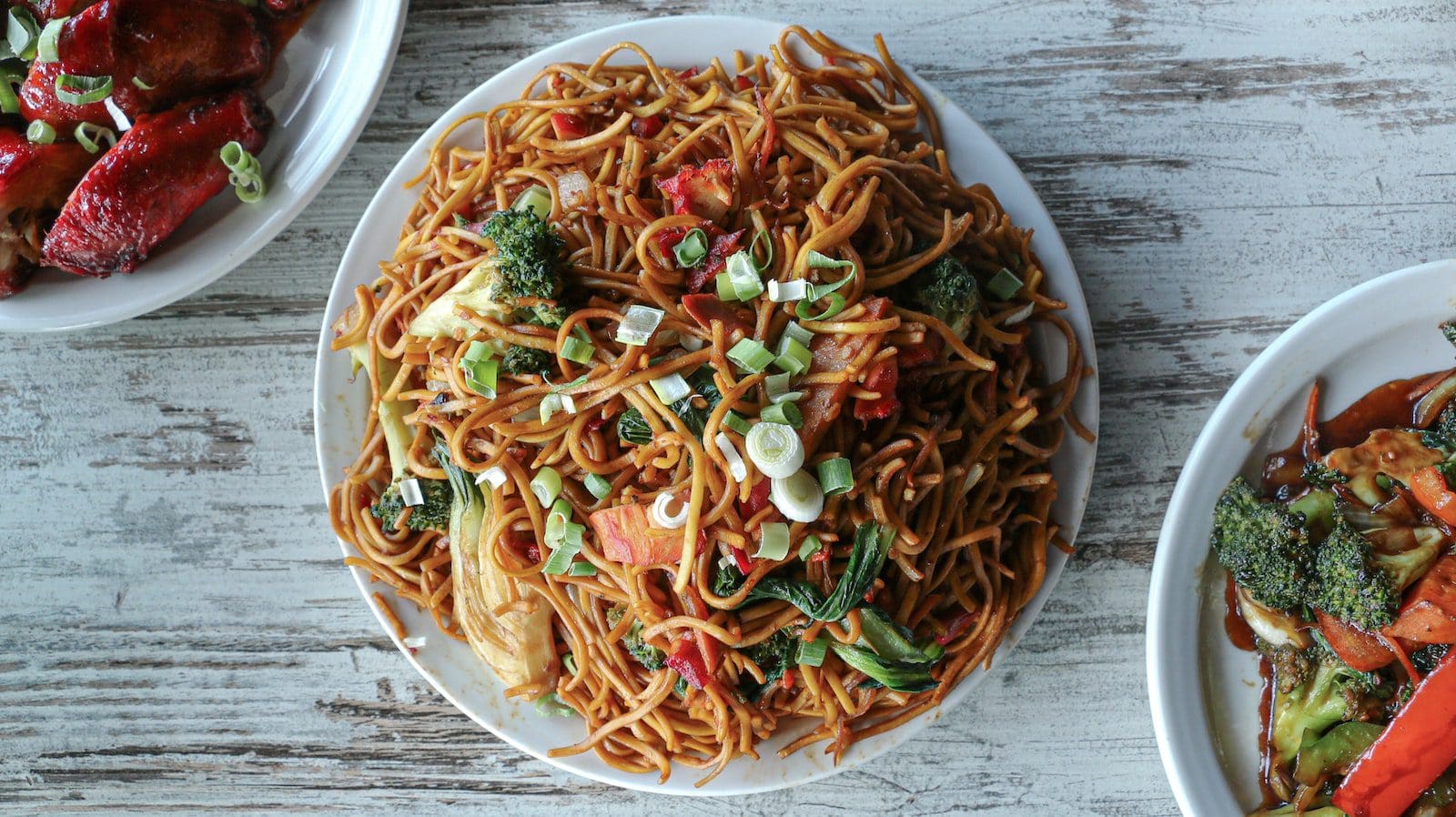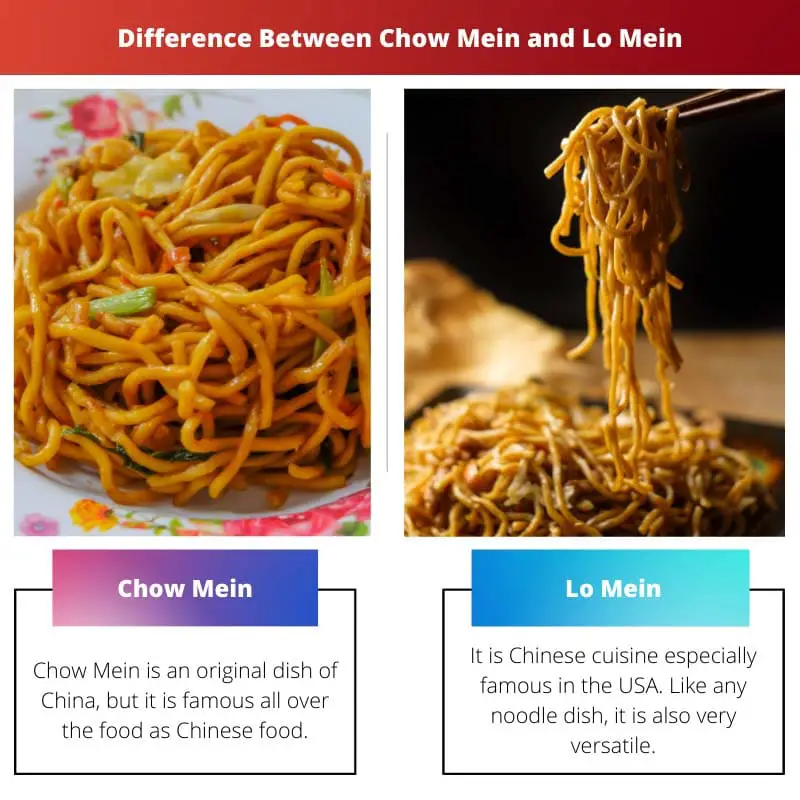There are several dishes famous all over the world for their exquisite taste and flavour. For example, dosa, pasta, momos, etc. They are eaten and preferred by a lot.
Most of them are different in appearance and taste, etc., but some of them are similar in many ways that not many can distinguish between both. Among such dishes are Chow Mein and Lo Mein. Both of them are famous dishes of China that are liked by many. But not many know how they differ.
To have a better understanding of both of the dishes, the following article contains information and difference on both of these dishes.
Key Takeaways
- Chow Mein is a crispy noodle dish that is stir-fried with vegetables and meat, while Lo Mein is a soft noodle dish that is boiled and stir-fried with vegetables and meat.
- Chow Mein noodles are thinner and crisper than Lo Mein noodles, which are thicker and softer.
- Chow Mein is commonly served as a side dish, while Lo Mein is a main course.
Chow Mein vs Lo Mein
The difference between Chow Mein and Lo Mein is in their methods of cooking. Chow Mein is fried, while Lo Mein is not fried. Both of them have different textures and complexions. Sauces are not always added to both dishes, the shape of noodles used for them also differ. They have different traditional names too.

Chow Mein is a Chinese dish prepared with round-shaped noodles. It is made from wheat flour and is stir-fried. It has a crispy texture and looks dark in color after cooking. It is mainly dry but sometimes can be wet or sticky too.
Noodles should not be overcooked as it is the base of the whole dish. It is also called Chow Mian.
Lo Mein is also a Chinese dish prepared with flat noodles (wheat flour). It is extremely soft in texture and appearance, and it is light in color. It has more flavours due to the addition of different sauces. It is never dry. It is rich in nutritional content due to the presence of vegetables.
Comparison Table
| Parameters of Comparison | Chow Mein | Lo Mein |
|---|---|---|
| Literal Meaning | Stir-Fried Noodles | Tossed Noodles |
| Texture | Crispy | Soft |
| Shape | Flat or rounded | Flat |
| Sauce | Dry noodles | Saucy noodles |
| Traditional name | Chao Mian | Lo Mian |
What is Chow Mein?
Chow Mein is an original dish of China, but it is famous all over the food as Chinese food. It tastes spicy and comes in several forms, vegetarian and non-vegetarian. It can be cooked with eggs and chicken and with vegetables.
Every country has its version of Chow Mein, the basic difference it has is that it is boiled first and then stirred out of the water, after that, it is fired with all other ingredients. Although there is no addition of sauces, some dark sauce such as soy sauce is added in this to add a special taste.
Vegetarian Chow Mein is the most famous among all as it is consumed by the largest population in the world.
Veg Chow Mein includes mainly three ingredients, Noodles, Vegetables (onion, corn, capsicum, cabbage, etc.) and some dark sauces (soya sauce, vinegar, etc.). Non-veg Chow Mein is prepared in the same manner, just a step of some eggs or chicken is added along with vegetables.
The main things that have to be taken care of include: noodles should be properly cooked, a large pan should be used for cooking, vegetables should be stir-fried, and everything should be mixed properly.

What is Lo Mein?
It is Chinese cuisine especially famous in the USA. Like any noodle dish, it is also very versatile. It can be cooked with vegetables and chicken or eggs. It is important to cook the noodles carefully as they should be soft and easily chewed.
Noodles should stay intact and not clump. Fresh noodles should be used, and any packed noodles should be avoided. They should be kept in a dry and cold place.
Several vegetables can be used in Lo Mein, such as mushrooms, tofu, carrots, onions, peas, cabbages, etc., except this meat, chicken, eggs, or even fish can be used as ingredients.
The recipe is the same as Chow Mein just the difference is that in case Lo Mein, the noodles are just boiled, not fired. This also makes it a healthier option as it does not contain any extra calories or fat due to oil or frying.
It is prepared pretty soon as nothing vast has to be done for the preparation. It also contains several types of sauces that add exquisite flavours to the dish.
The vegetable or chicken must be cooked very well and easily chewed. Although its origin is in China, it is famous in other parts of the world.

Main Differences Between Chow Mein and Lo Mein
- The literal meaning of both noodles is different, although Mein means noodles, the initial word of them have different meanings, such as Chao means stir-fired Lo means tossed. This also explains the method used for them to cook. Chao Mein is boiled and then fired also, and then later on, extra flavours are added to them, whereas Lo Mein is boiled, and then flavours are added, they are not fired at all.
- Due to frying, both of the noodles have different types of textures. The frying makes the noodles of Chow Mein Crispier, whereas Lo Mein noodles are not fired therefore, they have a soft texture.
- Different types of noodles are used for making these dishes, for Chow Mien, mostly round noodles are used, while for Lo Mein, mostly flat noodles are used.
- In the case of Chow Mein, sauces are not important they are more dry noodles in fact, if the sauces are added, mostly dark sauces are added, while in the case of Lo Mein sauces are always added and that also white sauces. This implies that Chow Mein has a relatively darker complexion than Lo Mein.
- Both of the dishes have different traditional names; while Chow Mein was earlier called Chao Mian, Lo Mein was earlier called Lo Mian.
- Although both of them are healthy, if compared due to frying Chow Mein is less healthy when compared with Lo Mein which is boiled.

The comparison table was particularly helpful in summarizing the key differences between Chow Mein and Lo Mein. It made it easy to understand and remember the distinctions.
I found that to be the most useful part of the article as well. It really helped to clarify the different aspects of these dishes.
The breakdown of what goes into both Chow Mein and Lo Mein was very insightful. It helped me understand the key elements that make each dish distinct.
I completely agree, understanding the specific components of these dishes really enhances the dining experience.
I wasn’t aware that Chow Mein and Lo Mein differ in the shape of their noodles. This was a very enlightening read.
Absolutely! The cultural nuances in the preparation of these dishes are truly fascinating.
Yes, that was an interesting detail to learn about! It’s amazing how many small differences come together to create a unique dish.
I appreciated the information on the preparation and nutritional content of Chow Mein and Lo Mein. It’s great to know the differences in ingredients and cooking methods.
Definitely, knowing what goes into the preparation helps in making informed choices about what to order and eat.
Absolutely, it’s important to understand the nutritional aspects of the food we consume, and this article did a great job in providing that.
I appreciate the detail about how Chow Mein and Lo Mein are cooked and their traditional names. It’s always fascinating to learn about the origins and preparation methods of different international dishes.
Definitely, the cultural and historical context adds a whole new layer of appreciation for these dishes.
Learning about the specific differences between the noodles used in Chow Mein and Lo Mein was really enlightening. It’s fascinating how small variations can make such a big difference in a dish.
Absolutely! It’s amazing to see how such nuanced details can have a big impact on the taste and texture.
I completely agree, the noodle texture plays such an important role in the overall experience of the dish.
This was a very informative article, it provided a comprehensive comparison between Chow Mein and Lo Mein. It was especially interesting to learn about the different cooking methods and how the texture and taste differ as a result.
Yes, I agree, it was great to learn about the literal meaning of both dishes and how their traditional names differ.
The detailed descriptions of the cooking techniques of Chow Mein and Lo Mein were very enlightening. It really helped to visualize the differences.
Agreed, understanding the nuances in the cooking process helps in appreciating the art of food preparation.
This article provided a comprehensive comparison of Chow Mein and Lo Mein. I feel like I have a much better understanding of these dishes now.
I found the section on the traditional names and the literal meanings of Chow Mein and Lo Mein to be quite intriguing. It added a whole new layer of insight to these dishes.
Absolutely, understanding the linguistic and cultural origins of these foods is really fascinating.
It really deepens the appreciation for these dishes to learn about their traditional names and meanings.